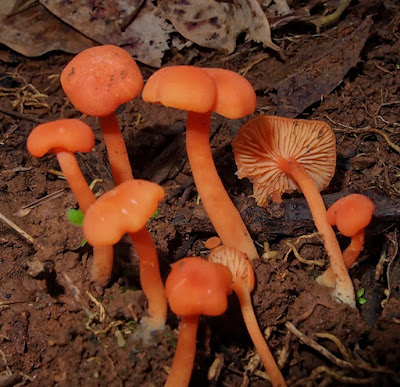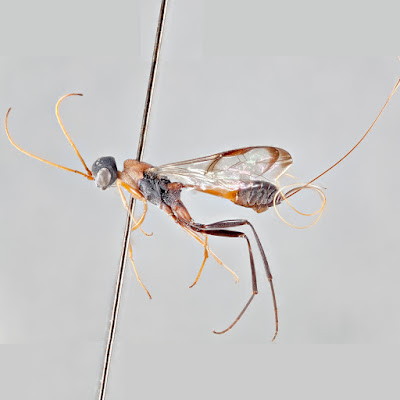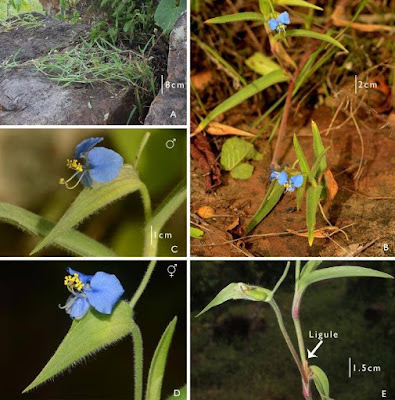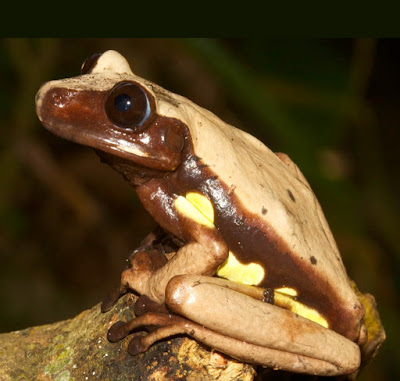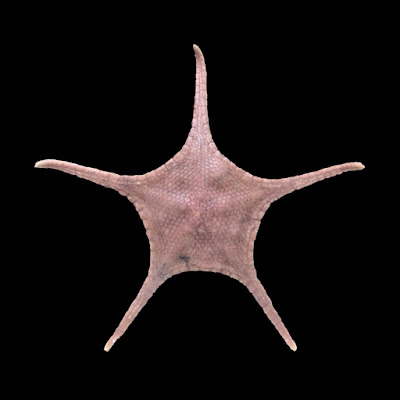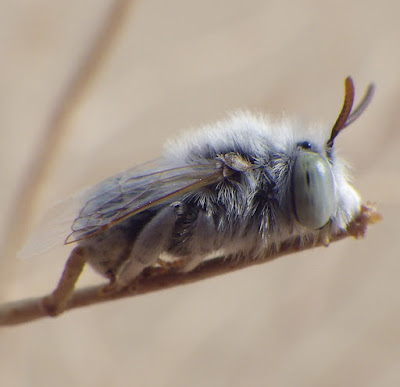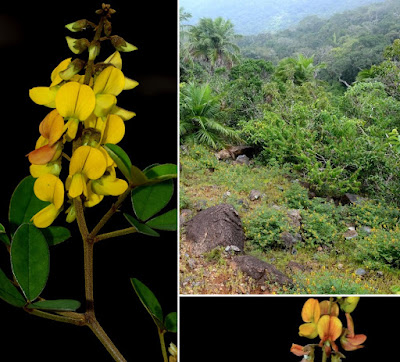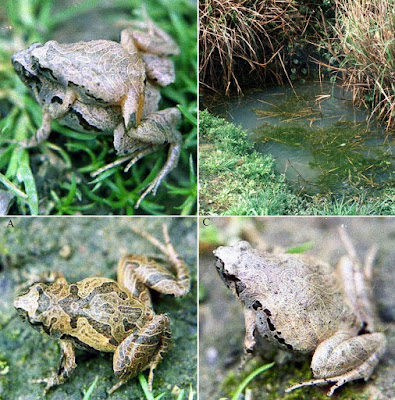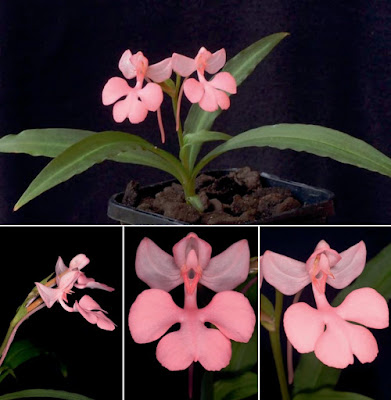[Most Recent Entries] [Calendar View]
Thursday, December 27th, 2018
| Time | Event | ||
| 6:08a | [Ichthyology • 2018] Rasboroides vaterifloris & P. pallidus • Undocumented Translocations Spawn Taxonomic Inflation in Sri Lankan Fire Rasboras (Actinopterygii, Cyprinidae)
Abstract A recent (2013) taxonomic review of the freshwater-fish genus Rasboroides, which is endemic to Sri Lanka, showed it to comprise four species: R. vaterifloris, R. nigromarginatus, R. pallidus and R. rohani. Here, using an integrative-taxonomic analysis of morphometry, meristics and mitochondrial DNA sequences of cytochrome b (cytb) and cytochrome oxidase subunit 1 (coi), we show that R. nigromarginatus is a synonym of R. vaterifloris, and that R. rohani is a synonym of R. pallidus. The creation and recognition of unnecessary taxa (‘taxonomic inflation’) was in this case a result of selective sampling confounded by a disregard of allometry. The population referred to R. rohani in the Walawe river basin represents an undocumented trans-basin translocation of R. pallidus, and a translocation into the Mahaweli river of R. vaterifloris, documented to have occurred ca 1980, in fact involves R. pallidus. A shared haplotype suggests the latter introduction was likely made from the Bentara river basin and not from the Kelani, as claimed. To stabilize the taxonomy of these fishes, the two valid species, R. vaterifloris and R. pallidus, are diagnosed and redescribed, and their distributions delineated. We draw attention to the wasteful diversion of conservation resources to populations resulting from undocumented translocations and to taxa resulting from taxonomic inflation. We argue against translocations except where mandated by a conservation emergency, and even then, only when supported by accurate documentation. Rasboroides vaterifloris Deraniyagala, 1930 Rasbora vaterifloris Deraniyagala, 1930: 129 Rasbora nigromarginata Meinken, 1957: 65–68 Rasbora vaterifloris var. nigromarginatus Deraniyagala, 1958: 137 Rasboroides nigromarginatus (Meinken, 1957): Batuwita, De Silva & Edirisinghe, 2013 Diagnosis. Males of Rasboroides vaterifloris can be distinguished from males of R. pallidus by having the unbranched rays of dorsal, anal, pectoral and pelvic fins black along their entire length, more distinctly evident in the last unbranched ray of the dorsal fin (vs. the mentioned rays being the same color as other rays; in preserved specimens, interradial membranes of dorsal, anal, pelvic and pectoral fins with distinct, scattered melanophores (vs. absent or vaguely present only around the beginning). Females of R. vaterifloris have a lesser body depth (27.2–31.9% SL vs. 31.7–35.5) than those of R. pallidus. Rasboroides pallidus Deraniyagala, 1958 Rasbora vaterifloris pallida Deraniyagala, 1958: 136. Rasbora vaterifloris ruber Deraniyagala, 1958: 136. Rasbora vaterifloris rubioculis Deraniyagala, 1958: 136. Rasboroides rohani Batuwita, De Silva & Edirisinghe, 2013 Diagnosis. The males of Rasboroides pallidus can be distinguished from the males of R. vaterifloris by having the unbranched rays of dorsal, anal, pectoral and pelvic fins the same color as other branched rays (vs. black along their entire length); in preserved specimens, interradial membranes of dorsal, anal, pelvic and pectoral fins without distinct scattered melanophores throughout or with only minute, vague melanophores only around the beginning (vs. melanophores distinctly present). The females of R. pallidus have greater body depth (31.7–35.5% SL vs. 27.2–31.9) than females of R. vaterifloris. Conclusion: As a freshwater-fish genus endemic to Sri Lanka and restricted largely to streams draining the island’s dwindling rainforest estate, Rasboroides attracts considerable conservation attention. The National Red List (MOE, 2012) treats ‘R. nigromarginatus’ as Critically Endangered and R. vaterifloris as Endangered. The synonymy of these two nominal species demonstrated here allows their ranges to be combined, widening their extent of occurrence and area of occupancy and hence potentially lowering the threat-status of R. vaterifloris. Although ‘R. rohani’ has not as yet been assessed for conservation purposes, its restriction to a small population at a single locality would almost certainly have caused it to be ranked as Critically Endangered. Given that we show here that it represents only an undocumented translocation of R. pallidus, its population is now only of marginal conservation concern. Indeed, of the two valid species of Rasboroides, R. pallidus enjoys the wider range and hence warrants less conservation concern, especially given its successful translocation to two river basins (Mahaweli and Walawe) in which it did not previously occur. In describing ‘R. rohani’ as a new species, Batuwita, De Silva & Edirisinghe (2013) were misled by apparently collecting only the largest specimens for their sample while neglecting to account for allometric growth. It is additionally regrettable that the type series of ‘R. rohani’ designated by these authors cannot be identified in the collection of the National Museum of Sri Lanka, in which it was stated to be deposited. Both translocations referred to in this paper were made by well-meaning citizens but without the safeguards that should apply in such cases. Perhaps most egregiously, no records were published of the rationale for translocation or the precise identity and origin of the source population. We urge that any future attempts to introduce species to novel habitats be guided by IUCN/SSC (2013) and that the intentional release or introduction of species without legal sanction be prohibited in Sri Lanka. Hiranya Sudasinghe, Jayampathi Herath, Rohan Pethiyagoda and Madhava Meegaskumbura. 2018. Undocumented Translocations Spawn Taxonomic Inflation in Sri Lankan Fire Rasboras (Actinopterygii, Cyprinidae). PeerJ. 6:e6084. DOI: 10.7717/peerj.6084 | ||
| 7:08a | [Fungi • 2018] Hygrocybe indica • A New Species of Hygrocybe from Kerala State, India
Abstract Hygrocybe indica sp. nov. is described based on specimens collected from Kerala State, India. Morphology-based methods and phylogenetic analyses of sequences of the internal transcribed spacer (nrITS) and nuclear large subunit (nrLSU) of the ribosomal RNA gene were employed to confirm the novelty of this species. The phylogenetic relationship inferred from independent nrLSU and nrITS sequence data matrices confirmed the difference of this new species from other species of Hygrocybe for which DNA sequences are available. The phylogenetic analyses clearly assigned H. indica to the subgenus Hygrocybe. A comprehensive description, photographs of the basidiocarps and the microstructures, and comparisons with morphologically similar and phylogenetically related species and phylograms to depict the placement of the new species are provided. Keywords: Agaricales, Basidiomycota, Hygrophoraceae, phylogeny, taxonomy, Fungi K. P. Deepna Latha and Patinjareveettil Manimohan. 2018. A New Species of Hygrocybe from Kerala State, India. Phytotaxa. 385(1); 13–22. DOI: 10.11646/phytotaxa.385.1.2 | ||
| 8:19a | [Entomology • 2018] Systematics of the Parasitoid Wasp Genus Aulacus Jurine (Hymenoptera: Evanioidea: Aulacidae) from Australia
Abstract The Aulacidae is a small family of Hymenoptera that are parasitic on wood-boring beetles and wasps. They have a worldwide distribution but are generally poorly studied, particularly for the southern hemisphere. This study is part of a series that aims to describe the Australian fauna which is relatively species-rich compared with other regions. We describe 39 new Aulacus species from eastern mainland Australia and Tasmania: A. anici Jennings & Austin, sp. nov., A. aquilus Jennings & Austin, sp. nov., A. bamagensis Jennings & Austin, sp. nov., A. bashfordi Jennings & Austin, sp. nov., A. bicolor Jennings & Austin, sp. nov., A. boonanghiensis Jennings & Parslow, sp. nov., A. brabyi Jennings & Austin, sp. nov., A. broadi Jennings & Austin, sp. nov., A. burnsi Jennings & Austin, sp. nov., A. confusus Jennings & Parslow, sp. nov., A. dandenongensis Jennings & Austin, sp. nov., A. deansi Jennings & Austin, sp. nov., A. doddi Jennings & Austin, sp. nov., A. froggatti Jennings & Austin, sp. nov., A. glorious Jennings & Parslow, sp. nov., A. hackeri Jennings & Austin, sp. nov., A. insularis Jennings & Austin, sp. nov., A. jamberoo Jennings & Parslow, sp. nov., A. kittelae Jennings & Austin, sp. nov., A. kiwarrakensis Jennings & Austin, sp. nov., A. leai Jennings & Austin, sp. nov., A. mareebaensis Jennings & Austin, sp. nov., A. naumanni Jennings & Austin, sp. nov., A. nebo Jennings & Austin, sp. nov., A. neboissi Jennings & Austin, sp. nov., A. obcordellus Jennings & Parslow, sp. nov., A. pallidus Jennings & Austin, sp. nov., A. quickei Jennings & Austin, sp. nov., A. rieki Jennings & Austin, sp. nov., A. scitulus Jennings & Parslow, sp. nov., A. simsoni Jennings & Austin, sp. nov., A. smithi Jennings & Austin, sp. nov., A. tasmanicus Jennings & Austin, sp. nov., A. tiernyi Jennings & Austin, sp. nov., A. umbackae Jennings & Austin, sp. nov., A. walkeri Jennings & Parslow, sp. nov., A. warraensis Jennings & Austin, sp. nov., A. willamsi Jennings & Austin, sp. nov., and A. wrightae Jennings & Austin, sp. nov. We also redescribe 14 species: A. albimanus (Kieffer), A. aroueti (Girault), A. atriceps Kieffer, A. elegans (Kieffer), A. festivus (Kieffer), A. flavicornis (Kieffer), A. flavimanus (Kieffer), A. fuscicornis Cameron, A. longiventris (Kieffer), A. minutus Crosskey, A. pallidicaudis (Cameron), A. planiceps (Szépligeti), A. truncatus (Kieffer), and A. vespiformis (Kieffer). As well, A. nigriventris (Kieffer) is synonymised with A. albimanus (Kieffer) syn nov. This brings to 60 the total number of species known from Australia (71 for the Australian region), although one species, A. biroi (Szépligeti), remains incertae sedis. A key to Australian Aulacus species is presented, along with notes on taxonomic history and host relationships. Keywords: Hymenoptera, taxonomy, parasitic wasps, new species John T. Jennings, Ben A. Parslow and Andrew D. Austin. 2018. Systematics of the Parasitoid Wasp Genus Aulacus Jurine (Hymenoptera: Evanioidea: Aulacidae) from Australia. Zootaxa. 4538(1); 1-113. DOI: 10.11646/zootaxa.4538.1.1 | ||
| 8:50a | [Botany • 2018] Commelina rupestris (Commelinaceae) • A New Species of Commelina from India
ABSTRACT The present article describes and illustrates a new species of Commelina from dryland hillocks of Karnataka, India. The new species Commelina rupestris shares morphological similarities with C. badamica, C. hirsuta and C. attenuata, but differs in its perennial habit, knotted rhizomatous, definite base, broadly elongate, thickened tuberous roots, characteristically ligulate, linear to lanceolate leaves, minutely fused spathes, one- to two-seeded bilocular capsules, and stramineous to light brown, rostrate seeds. KEYWORDS: Commelineae, new species, ligulate leaves, India Commelina rupestris Nandikar & Gurav, sp. nov. Etymology: As the species preferentially grows in rock crevices, the epithet ‘rupestris’ denotes its rocky habitat. Mayur D. Nandikar and Rajaram V. Gurav. 2018. A New Species of Commelina (Commelinaceae) from India. Webbia: Journal of Plant Taxonomy and Geography. 73(2); 233-237. DOI: 10.1080/00837792.2018.1540743 | ||
| 1:49p | [Herpetology • 2018] The Advertisement Call of the Treefrog Nyctimantis rugiceps Boulenger, 1882 (Anura: Hylidae), with Notes on Its Natural History and Toxicity
Nyctimantis rugiceps Boulenger, 1882 (Fig. 1A) is a Neotropical treefrog (Duellman & Trueb 1976; Faivovich et al. 2005) known only from disjunct localities in Amazonian Colombia, Ecuador, and Peru (Pérez-Villota et al. 2009). This species has the skin of the skull co-ossified and reproduces—including calling behavior, egg deposition and tadpole development—in water-filled tree or bamboo cavities (Duellman & Trueb 1976; Duellman 1978). Given its secretive behavior, this is a poorly known species and, as noted by Duellman (1978: 169), “the major clue to the life history of Nyctimantis is the calling behavior of the males”. Unfortunately, the only quantitative description of the advertisement call of N. rugiceps is a brief passage in Duellman (1978) based on four specimens from Santa Cecilia, Ecuador, where important variables are missing (e.g., call duration). More importantly, graphs illustrating the waveform and spectrogram are missing. Considering these limitations and the importance of advertisement calls to the study of anurans (Köhler et al. 2017), we provide a quantitative description using a call recording obtained in Leticia, Amazonas, Colombia. Camila Camargo de Souza, Mauricio Rivera-Correa, Jose M. Padial and Santiago Castroviejo-Fisher. 2018. The Advertisement Call of the Treefrog Nyctimantis rugiceps Boulenger, 1882 (Anura: Hylidae), with Notes on Its Natural History and Toxicity. Zootaxa. 4532(3); 441–443. DOI: 10.11646/zootaxa.4532.3.8 | ||
| 2:00p | [Invertebrate • 2018] New Genera, Species and Occurrence Records of Goniasteridae (Asteroidea; Echinodermata) from the Indian Ocean
Abstract Modern goniasterids are the most numerous of living asteroids in terms of described genera and species and they have important ecological roles from shallow to deep-water marine habitats. Recent MNHN expeditions and historical collections in the USNM have resulted in the discovery of 18 new species, three new genera and multiple new occurrence records from the western Indian Ocean region including Madagascar, Glorioso and Mayotte islands, Walters Shoal, South Africa, and Somalia. This report provides the first significant contribution to knowledge of deep-sea Asteroidea from the Indian Ocean since the late 20th Century. Several deep-sea species, previously known from the North Pacific are now reported from the western Indian Ocean. Gut contents from Stellaster and Ogmaster indicate deposit feeding. Feeding modes of this and other deep-sea species are discussed. Comments are made on fossil members of included taxa. A checklist of Indian Ocean Goniasteridae is also included. Keywords: Echinodermata, Deep-sea, Indian Ocean, Valvatida, Oreasteridae, Goniasteridae, Asteroidea, feeding, diversity Christopher L. Mah. 2018. New Genera, Species and Occurrence Records of Goniasteridae (Asteroidea; Echinodermata) from the Indian Ocean. Zootaxa. 4539(1); 1–116. DOI: 10.11646/zootaxa.4539.1.1 | ||
| 2:07p | [Entomology • 2018] Revision of the Bee Group Anthophora (Micranthophora) (Hymenoptera: Apidae), with Notes on Potential Conservation Concerns and A Molecular Phylogeny of the Genus Abstract Anthophora (Micranthophora) comprises the largest subgenus of Anthophora in the Western Hemisphere, with 26 species. Though previously synonymized with the Anthophora (Heliophila), Anthophora (Micranthophora) is here confirmed as a subgenus, morphological and multi-gene molecular phylogenetic evidence refute this and the synonymy of A. (Micranthophora) to A. (Heliophila) is formally rejected. Characters for (Micranthophora) are given and a key to species is provided. Seven new species are described: Anthophora (Micranthophora) caudata Orr, sp. nov.; Anthophora (Micranthophora) chihuahua Orr, sp. nov.; Anthophora (Micranthophora) escalante Orr, sp. nov.; Anthophora (Micranthophora) parkeri Orr, sp. nov.; Anthophora (Micranthophora) rara Orr, sp. nov.; Anthophora (Micranthophora) striata Orr, sp. nov.; and Anthophora (Micranthophora) timberlakei Orr, sp. nov. Further, four new synonyms are enacted: A. arthuri and A. flexipes to A. albata, A. nigritula to A. exigua, and A. xanthochlora to A. pachyodonta. Distributional and phenological data, as well as known details of nesting biology and floral specialization, are provided. Future research directions and species of potential conservation interest are also discussed. Keywords: Hymenoptera, Apoidea, Anthophorini, Heliophila, systematics, taxonomy, new species Michael C. Orr, James P. Pitts and Terry Griswold. 2018. Revision of the Bee Group Anthophora (Micranthophora) (Hymenoptera: Apidae), with Notes on Potential Conservation Concerns and A Molecular Phylogeny of the Genus. Zootaxa. 4511(1); 1–193. DOI: 10.11646/zootaxa.4511.1.1 | ||
| 2:18p | [Botany • 2018] On the Occurrence of Crotalaria uncinella subsp. elliptica (Fabaceae) in Andaman and Nicobar Islands, India
Abstract We present a first wild record of Crotalaria uncinella subsp. elliptica (Fabaceae) from Saddle Peak National Park, North Andaman, India with its comprehensive morphological description, illustration, photographs and lectotypification. Keywords: Crotalarieae, subspecies, Roxburgh, India, new addition, Eudicots Mayur D. Nandikar, K. C. Kishor and Nilesh V. Malpure. 2018. On the Occurrence of Crotalaria uncinella subsp. elliptica (Fabaceae) in Andaman and Nicobar Islands, India. Phytotaxa. 379(1); 73–77. DOI: 10.11646/phytotaxa.379.1.7 | ||
| 3:00p | [Herpetology • 2018] Microhyla beilunensis • A New Species of Genus Microhyla (Anura: Microhylidae) from Zhejiang Province, China
Abstract We described a new species, Microhyla beilunensis sp. nov., from Zhejiang Province of China. Phylogenetic analyses based on the mitochondrial 12S, 16S and CO1 gene sequences suggested that the new taxon was distinctly separated from its congeners and closed to M. mixtura and M. okinavensis. Morphologically, the new species could be identified from its congeners except M. mixtura by several characters: (1) rudimentary webs on toe base; (2) absence of disks and dorsal median longitudinal grooves on finger tips; (3) presence of disks and dorsal median longitudinal grooves on toe tips. As well, the new species could be identified from topotype M. mixtura by the combination of characters: (1) apart from the stripes, bar-shaped and oval-shaped patterns, the rounded spots present on the dorsum of body and legs; (2) the outer metacarpal tubercles prominently larger than the inner one; (3) of males, the ratios of HW, IND, UEW and LAW to SVL of the new species were significantly larger than those of M. mixtura (P < 0.01), and the ratios of SL, IOD, LAHL, HLL, TL, TFL and FL to SVL of the new species were significantly less than those of M. mixtura (P < 0.05). Keywords: Microhyla; morphological comparison; new species; phylogenetic analysis; taxonomy; Zhejiang Microhyla beilunensis sp. nov. Microhyla mixtura: Fei, Ye, Xie and Cai. 1999. Chin Zool Res, Beijing (Beilun, Zhejiang): 239−240. Etymology: This specific name beilunensis is a Latinize toponymic adjective that refers to Beilun District, Ningbo City, Zhejiang Province of China, where the new species was collected. For the common name, we suggest Beilun Pygmy frog (English) and Bei lun ji wa (Chinese). Diagnosis: The new species is allocated to the genus Microhyla, because it is consistent with the generic diagnostic characters: relatively small body size; maxillary and vomerine teeth absent; vomer divided into two parts and disappearing at the posterior edge of the choana; tongue posteriorly rounded; skin smooth or with tubercles; tympanum hidden or indistinct; 1−2 row of horizontal skin ridges on the palate; fingers without webbing; toes webbed or free of webbing; 2 or 3 metacarpal tubercles; the absence of supernumerary tubercles below the base of fingers and toes; the absence of skin ridge or skin projection between the subarticular tubercles of toes III and IV (Parker, 1934; Fei et al., 2005, 2009). Distribution and habits: Microhyla beilunensis sp. nov. is now known only from the type locality, Beilun District, Ningbo City, Zhejiang Province of China. This species lives in the water pits or ponds about 3 m diameter or adjacent grass thickets, subterranean holes and mud pits in the mountainous regions at elevation 1400 m a.s.l. The male frogs make vibrating calls on the last 10 days of March. Small tadpoles seen in the early April would dive to the bottom when disturbed. On the 9th April 1998, four gravid females, egg groups, and small tadpoles were found. Mating of females and males took place in the pond of imitated natural eco-breeding in Chengdu (Fei et al., 1999). Small tadpoles were found in the last 10 days April. It took 60 days for the fertilized eggs to finish metamorphosis. Newly metamorphic frogs were 8−10 mm. Sympatric species of amphibians in the Beilun District during the surveys includes Hynobius yiwuensis, Echinotriton chinhaiensis, Bufo gargarizans, Rana zhenhaiensis, Pelophylax nigromaculatus, Sylvirana latouchii, Fejervarya multistriata. Meihua Zhang, Liang Fei, Changyuan Ye, Yufan Wang, Bin Wang and Jianping Jiang. 2018. A New Species of Genus Microhyla (Amphibia: Anura: Microhylidae) from Zhejiang Province, China. Asian Herpetological Research. 9(3); 135-148. DOI: 10.16373/j.cnki.ahr.180032 | ||
| 3:03p | [Botany • 2017] Habenaria janellehayneiana (Orchidaceae) • A New Species from northern Thailand
Abstract A new species, Habenaria janellehayneiana Choltco, Moloney, & Yong Gee is described. It is native to Phitsanulok, northern Thailand. It is characterized by possessing stigmas that are parallel basally, with apices convergent, the tips touching, or nearly touching. A character that is absent in the remaining members of the Habenaria “rhodocheila complex”. A key is provided differentiating it from both Habenaria erichmichelii, and Habenaria rhodocheila. |
| << Previous Day |
2018/12/27 [Calendar] |
Next Day >> |




